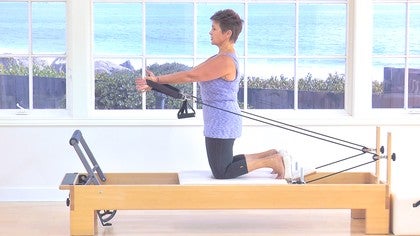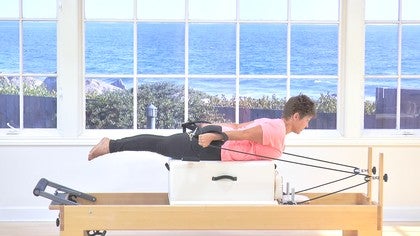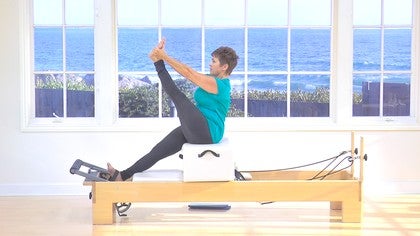Description
This class is the first in a series of three Reformer workouts that progress in skill and difficulty. We hope you try all three workouts!
About This Video
Transcript
Read Full Transcript
This is a reformer fundamental workout and this is going to be a series of three different workouts where we use the fundamentals that we create in this initial session to create good, strong key connections. I like to call them into the other exercises, but as we start this reformer workout, I want to acquaint you with what I call the abcs and what that means. During all these fundamentals, we're going to work on activation versus aggravation, so we want to invite the right muscles for the right task. Some muscles are movers and some muscles are stabilizers. Again, a is for activation as opposed to aggravate muscles. B will be, we'll be inviting the breath in. Remember, part of the exercise is all about the breath and the ease of breath versus bulging. Some people think you can only bulge in your abdomen, but you can actually bulge in your neck and bold in your cheeks.
You can actually bulge by bearing down. We don't want any bulging going on. We want the breath to come in and the breath to go out. And then the letters see that I refer to is connecting either within the exercise or between the exercise, always being aware of what's going on. So we're going to connect as opposed to collapse. So one more time. A is um, activate versus aggravate.
B is breathe versus bulge and C is connect versus collapse. Typically when we start and the reformer, we start with foot work. I have it on three red springs. So this particular workout is not going to go really fast. It's more given here to educate you on some of the fundamentals.
We're going to start with footwork here and my heels are on the bar. My toes are pulled back, my feet are at 90 degrees. Hughes me, my thighs are at 90 degrees or a little bit less. They're not way, way in towards my torso. My pelvis is in the neutral position. How do I find the neutral position while I put my palms on the top of my hip points and angle my fingers down towards my pubic bone? My head rest is in the up position supporting my neck.
So again, I'm going to straighten my legs out, lengthening out my thighs, pulling in my belly without changing anything. My face is soft, my neck is relaxed. And then it had been my knees and come in minute. Inhale out and then exhale, soften, sink, relax everything as I come in and take my arms down by my side. Now just so you can see that my pelvis isn't moving, and now pause for a second with me and let's make a key connection behind the thighs. With my heels on the foot bar, I'm actually going to press my heels to the floor as if I'm trying to wipe off mud on the bottom of my feet. Okay, so I'm going to press my feet down to the floor.
That starts to give me a little activation behind my buttocks and my thighs. Everything stays stable here and I press and I pulled back in. My Feet, press down as I go out and they press down again as I come in, inhaling and exhaling and inhaling and exhaling. We'll do this two more times. Feet press down and then come in. And last time out and last time, the important thing about this exercise on the footwork is that this reformer is a beautiful piece of equipment.
It is not just another excuse to do a leg press. There's a piece of equipment in the gym for that, but that's not what this is. So this beautiful piece of equipment is allowing us to make the connection through our head, our neck, our chest, our trunk, our pelvis, our thighs. And now we're going to take that connection from the heels and slide down your feet to the balls of the feet. Or we also call this prehensile. It's four foot flection.
So the four foot of the of your feet are actually reaching over inflection and the heels are reaching down. My feet again are pressing down to the floor. My belly is gently pulled in, my neck is soft, and then press and then pull. The heel position is not changing. I'm trying to maintain my toes, curling as my heels stay curled as well. Not going to change the position of my pelvis, not gonna change the position of my ribs.
I'll do three more and two more, and then one more and then pause. I'm going to leave my feet here. I'm going to take an inhale and now I'm going to exhale. Press out and inhale, come in, exhale.
If I turn my palms downward and press my palms down in the back of my arms, down in the back of my shoulders down, I can do so without d, without disturbing anything else. Go ahead and try that. Press your arms down to the mat. Notice what happens to your shoulders or your chest or your jaw. If when you press your arms down, you press so hard that your back actually presses down and maybe your head changes like this, then maybe it's not a good idea for you to press your arms down specifically. And then you might want to bend your arms too.
What I like to call the six shooter position, and then you're going to take the back of your arm and just press it down because maybe it's the position of your forearms that's tight. So make that connection and see how your body behaves when you do that. And then go ahead and straighten out your elbows, like you're going to karate, chop the reformer and see if that feels a little bit different. So let's try that there with our feet still in this prehensile position, pressing down and then bending in. Inhaling and then exhaling. Let's do that one more time and then last time so you can make the decision on how you press your arms, depending on what it does to your upper chest and your neck.
We're now going to change to what we call the [inaudible] v position. And if you look, your toes are on the bar, your heels are together, your toes are apart, and when I lift my heels, my legs think they're longer. So sometimes this is an opportunity that people want to press their back. Can you see that? This is a buttocks pressing up. This is a bulging thigh here. We don't want that. We don't want any tucking. The neck changes.
Everything gets confused. We have to erase and melt it back down into that position. Raising the heels. You pick the position of your arm, the heel stay locked in space. We press and then we bend. Squeeze the thighs together and then bend the knees.
Melting downward. Soft face, not clenching the jaw. Let's do more here. One and bend and two and bend and three and Ben. Again, make a special note that if you start to press out and your box starts to arch, then you need to come back in. Stop the exercise, check in, press out and make a mental. Ooh, it wants to change, but don't let it change. Maybe lifting your key goal or your pelvic floor a little bit. See if you can make this connection, stay and then started, press out a little bit further and then Predator, press out a little bit further and then press all the way out and notice that eventually you keep it all nice and still as you go out and as you come in, bring the legs together, separate the feet.
The next exercise and the foot work is called tendon stretch. So I'm going to believe my heels high. I'm going to press out, stay long in my torso in the middle, lower the heels under. As I start to lower the heels, the pelvis really wants to change. I'm not gonna let it and then I'm going to raise up and I'm going to check in. My eyes are looking straight up to the ceiling.
My neck is soft and then raise up. I'll do this two more times down and then lift, making special attention to that. My belly is not bulging and my breath is flowing easily and then I'm going to lower and raise one last time and then bring myself all the way back in again. A is activate and not aggravate. We're going to go through these exercises again and you'll do them with me and we'll do it at a little bit quicker pace. Starting with the heels, here we go.
Inhaling, exhale five times each. Go One and down and two and down. Stable trunk, relaxed face, four and five. Switching to the bird feet position, making a connection, not collapsing anything using the breath and not bulging one and down. Two, three, four and five.
A lot of these v heavy, the pelvis. The weight is across my sacral area and here we go. Five and four. Squeezing the thighs and making the connection. Three and two and then one and bringing it in.
Separate the heels apart, pressing out tendons. Stretch five and lift. Making the long connection behind the thigh all the way up to the buttocks without changing the shape of the spine. As the force of the heels go down here, the belly has to pull here and then Ben the news and bring yourself all the way back. Yeah, taking this foot work one step further. We'll separate the legs now and we'll take the thighs and we'll turn the thighs externally. Just a little bit opening up the groin.
Still take your heels and attract your heels towards each other. Make a connection between the inner thighs, press and pull, press and pull, softening the chest, adding the breath and Paul last time. Inhale and last time, exhale, and then go to the balls of your feet in this second wide position. When you go to the balls of your feet and you raise your heels, your legs get longer. So now it's a little bit longer journey. So press no bulging the abdomen.
Take one leg in and then put it down and take the other leg in. And then put it down. Lift one leg in, hold, scoop in the belly, relax your chest and throat. Lift the second leg up. Just remind yourself from your mat fundamentals that this is a very good exercise we're getting now to move to our arms, but just like to get a reacquainted with the core here again and then lower the leg and then lower the other leg. I'm going to roll to my side and sit up and I'm going to change from three springs to two red ones.
It gives me a little different feeling on my hand, so I put the handle on there. So again, you can have the foot strap, you could have the handle, you can have them both. So now from here,
So now I'm going to go ahead and take one leg in the tabletop. The arms are pulling on the arm straps. I'm going to take the other leg in and right away I have this connection in my core how my arms are related to my trunk. I'm going to pull my arms down without changing the position of my trunk. Inhale, arms up. If this to red springs, if these to red springs are too heavy, then of course you can lower it down.
You can use any variation that you need for what? In order to create the connection that you need between your arms moving your belly scooping. Now the arms come out to this side like a t and we pull and then we really inhale and then exhale. Inhale and exhale and checking in with the ease of movement in my neck. Excuse me, I'm checking in with whether or not my neck is overworking as I create the ease of movement in my arms. It is work. There's no doubt about it.
And how about two more? One. And then two. I'm going to go ahead and put my feet right down on the foot bar and bring my arms up in the air. Inhaling and exhaling. One more time. Big Inhale. One more time. Big exhale. Move the arms and lift both legs simultaneously.
And hold just right here. This particular position right here kind of sets the stage for other exercises that are to come. Now I'm going to add the circles. Arm circles. Exhale. Inhale up. Open. Exhale down. Close. Two more times of open. Exhale down close. One more time. Up Open. Exhale, down close. And now reverse down. Open. Whoa.
Here's the challenge. Here's a challengers or challenge and then press down as I opened my arms. My trunk needs to stay in control. One more time down. Oh one more time open, and then lower the legs down. I'm going to take these and put them on the handle here.
I'm going to come out of the supine position and I'm going to come into the quadrupedal position.
I'm going to choose a very light spring for my next series of exercises that will happen in Quadro pet. You've already done some of these exercises on the mat. They'll come a little bit more to light here as well. So in this quadramed position, you can even see as our prepare that this carriage is a little wobbly. So if you're a very beginner on the reformer, I want you to put a red spring on with that blue one. Okay?
Just for the sake of stability to start with while you listen to the exercise your head is in, I know over your time chest and your chest is over your pelvis. You're in this neutral position and your, your collar bones are open. You're in this position here. Press your shins down, so from this position, without changing anything, take an inhale and then as you exhale, the belly pulls in. Just lift your left arm up in the air and then put it down. Lift the right arm up in the year and then put it down.
Now take an inhale and as you exhale, don't move your arms, but press your legs behind you and then resist the spring in. Press the legs behind you. Resist the spring in. Now that you know what to expect, I'd like you to sit back and take that red spring off. Again, I want the reformer to be very loose. I want it to be a challenge in this quadruped head position with my hands on the foot bar and my body in this quadriped head position and my belly pulled in the lengthening of my tailbone, my neutral pelvis, like something is right underneath my chin, reaching long. Now with this very light spring, Whoa, I'm going to push out and then pull it in. Inhale, and then exhale. Here's what might happen to you as you go out.
You may try to do that and your back may take over. We're not gonna do that. And so sometimes what happens is your body wants to compensate and it just wants to do this and it wants to hang on and Tuck and all that. But what we're getting at here is this nice, neutral position, long abdomen, no tucking, natural curve in the back, natural curve in the neck. And then two legs, press two legs, pull. My shoulders are staying over my arms as I challenge my trunk to control the movement of my legs. We'll try this two more times. Now we're going to a little challenge.
Now I will take my arms to push my whole body back for one, and then return arms, push back, and then return. Now I'm going to add yes, the combo arms, legs, legs, arms, arms, legs, big challenge, legs and arms. One more time. Arms. Good core control here. As these legs go out, keep the core. As it comes in, everything comes back. Sit back and pause. Now we're going to challenge this by offsetting the arms. So take both of your arms over to the right hand side, but pay special attention that your body is still facing. Straight ahead.
Arms, legs, legs, arms, arm, angle changes, leg, a goal changes, leg angle returns, armpit angle returns. One more time out, legs, legs and arms offset the other side. You'll notice for a second the position of my wrist. I am not way down under here with my shoulders internally rotated like this because this is just me kind of hanging on here and resting in my chest. We don't want it to look like that. So I'm going to take my hands and I'm going to put the weight right here on my palm and my fingers are kind of angled down.
If you got sweaty, you could put some uh, you know, like shelf liners, some sticky paper there. So again, back to the exercise. We're offsetting here to the left, lengthening out, checking in, and then arms, legs, legs, arms, arms, legs, legs, arms. One more time, arms and legs, legs, return and arms. And then pause yourself right there. In future workouts, we'll do some variation with the arms and legs and alternating into one arm and one leg and all that. So you have to stay tuned for that one. What I'd like you to do now is to put on two red springs remembering this as a fundamental workout. We're creating our key connections that will allow us to advance later on.
Nothing. Nothing will ever take the place of good, strong fundamentals and understanding how to create these connections. The next set of exercises that we'll do, we'll be with
So with my legs out at an angle, there's a tendency to want to arch up like this, but we know we're not going to do that. Keeping the connections here, I'm going to turn the thighs out ever so slightly. Bend my knees in two what I call this 90 degree position here, the knees, the thighs are reaching downward in the bellies pulled in. So I am not resting in my low back here. The weight is distributed equally right across my buttocks area. We'll do some frogs here so we press the legs away, squeezing the thighs together and then bending the knees in, pressing the legs away, and then bending the knees in two more times like this press.
And then Ben. And last time press and last time bend. Don't be surprised here. If you start getting a little quivery in this holding position, there's often a tendency to let the legs come all the way back in, which actually collapses your body. Can you kind of see how my chest is collapsed?
My neck has collapsed back and I'm just hanging here. So we want to clean this up and we want to recognize where neutral is in the pelvis, where the ribs are and where the neck is. So we're going to do these again. Now. Press and bend, differentiating this neutral pelvis with our hips moving to more and then last time. Now if you do need a stretch in your low back, you will allow your knees to come back. You will allow your tailbone to curl because you've invited it, not because you've just gone into a collapse. All right, so my tailbone is lifted now, but I have not collapsed anything in my body. I've let the straps pull me to stretch my lowest back, making this connection through my thighs.
Now I'm going to differentiate this post Uri or tilting if you will, bringing my legs back to vertical, resting my pelvis, heavy making connection here. Back to neutral again, press and Ben. A lot of times in a reformer workout it's all about differentiating which part of your body you're asking to do what? I'm going to do this two more times. Press and bend. One more time. Press and pause. Now I will take my legs kind of up towards the ceiling and I'm going to turn them parallel and then I'm going to turn my toes in and my heels out.
Parallel. Toes out. Heels in, external rotation of the thighs. Parallel toes in, heels out, internal rotation of the thighs. One more time. Heels in, toes out. Extra Annal rotation. And then I'm going to stop in parallel. My legs are turned on, the front of my legs are working, the back of my legs are working. I'm not just hanging. The next exercise, our leg circles.
Inhale up open. Exhale down close. Inhale only to the distance that your pelvis does not curl up so it's not this up open and then down. Cause look at my neck going for a ride. Don't want that to happen. Next days, soft neck lengthening. Inhale up open. Exhale down close.
So here's a little bit tighter hamstring. Maybe your circles aren't quite as big and your legs don't go as high. But this is a neutral exercise. So the weight distribution on my back side does not change. One more time, up open and then down close.
And now we're reverse open. Come up and close. Incidentally, I can go into external rotation as well. I can, yeah, parallel feet down and open and up and close. And I could even go into internal rotation. It affects my hip muscles differently and then bend my knees into that same frog shape. Invite my knees in, invite my tail bone to curl. Not by collapsing, but by connecting through the invitation, through the action of my tailbone. Lifting.
Isn't this kind of like rolling like a ball on the mat work? If I were, if my knees were back and my tailbone was curled in, my trunk was lifted, that would kind of be rolling like a ball. I'm going to take one of my legs out, put it down on the foot bar and take my other legs out and put it down on the foot bar and hang my straps right back up here on the hooks in a role to my side and come on up and grabbed my box. When we placed the box this way, it's called short box. When we placed the box this way, it's called long box, so we're going to place it in this short box position and for today's workout, it doesn't matter if it's behind the shoulder rest or not because we're not going to be doing much on the box except for sitting on it. Moving our arms a little
I'm going to leave my feet on the board here, or excuse me, on the edge of the reformer. Pull my tummy in and lengthen my torso up. My pelvis is in neutral. My front ribs and my back ribs are all lifted. I'm going to take an inhale and then an exhale, and then take an inhale. Yeah, and then an exhale. My arms are going to come out in front. Inhale, raise my arms up without changing the shape of the spine. Exhale, the arms come down. Inhale, the arms come up. Exhale, the arms come down. One more time, the arms come up, and one more time. The arms come down your breathe again. Expanding my rib side to side, and then letting my ribs come in. I like to say expanding my ribs, eastern west. Inhale.
I just call it kick your leg. So it looks like this without changing the shape of your spine and without Tenzing your neck, you're just going to take your right leg and kick it out and bend it and kick it and bend it. If you need to put your hand behind your thigh to support it, you can, but I don't want you to fall over and collapse as you do this. I want you to stay connected into your torso, connected through your front and back ribs lifting, and you stretch the leg and then bend it one more time, stretch. And then Ben left leg goes one and down and two and down and three and we'll now climb off the short box and we'll turn it into the long box.
I'm going to go back to two red springs in a lie on my tummy. On the long box. I'm gonna put my forehead on the foot bar.
Now the foot bar has different adjustments. If you needed to raise it and lower it, you certainly could. I'm just going to press my arms to take myself back and bend my arms to bring myself in. Depending on your body weight, this spring edge could be too heavy for you and you may actually feel like you're going to slide off the box. So you could certainly lower the spring, or you could put a little sticky pad underneath your thighs or your tummy so that you didn't sly exhaling. You'll notice here that I am neither lifting my spine nor collapsing my spine. Three more. Exhaling, two more exhaling and then last one and return yourself in.
Relax your head down. I'd like you now to pay attention to your elbows that they're gonna work predominantly in what we like to call the sagittal plane so that as you press out, your elbows stay narrow. Crown of the head is reaching long. I'm not lifting my head up. I'm minimizing raising my spine and I'm understanding, and I'm actually telling you that simply lying on your belly is an extension force for your spine. So you're actually getting extension, um, biomechanics without actually lifting. We will lift the spine into extension with some other exercises in our next workout. So continuing from here, I'm going to take my foot bar and lower it down and I'm going to leave my long box on. I call this a little bonus.
We're going to get into quadro pet on the box. I love the Quadrat head position. I love the challenges it offers the body. I want you to notice that my knees are actually at the back edge of the box and what that does is it challenged me because I can't press my shins down. So in this quadrupled position, now my left hand is going to push into the box kind of this way a little bit as is my right hand. It makes me have some nice core connections here. My crown on my head is long, my bellies pulled in.
So from here now I'm going to lift my left arm up and take my right leg out. This is really challenging and I hope you see me wobble because this is hard. We're going to straighten that back leg then to lengthen out the crown of the head. Pulling the belly in and then bringing everything down. Your body will want to use some of its own strategies to compensate, but don't let it pull the tummy in and engage. Pulling this left arm in. Take the right arm out and the left leg out. Remember, they're not lifting really high, they're getting long.
Squeeze that left knee straight and then bring it down a little bit quicker. Now just to challenge. Inhale, exhale. Inhale, exhale. Inhale, exhale. Last one. Exhale. Sit back.
I'm going to stay pretty much in a neutral position here to get the feeling I'm gonna pull my tummy in. I'm going to press the legs back and then resist it back in with this deep crease in my hip press and then pull press and then Paul and I'm going to take one of the springs off and now the exercise will be easier in a different way and harder in a different way. So now I've got a challenge, the control so that I don't go like this out an n and change everything, so I'm going to come back into this neutral position here. Belize pulled in spine law. Inhale, exhale. This particular exercise will change its spinal shape as the exercise advances. What I'm trying to do now to teach you is to get the action of the buttocks as it relates to the thigh out and in. As I pull my tummy in.
Actually that's kind of a good exercise to take one hand away and do knee stretches. We'll add that in a later workout. One more time out, one more time in, and then bring yourself up. I'm going to add another spring on again to make the carriage a little bit stable. I'm going to move my feet to the middle of the headrest here and I'm going to see if I can pull myself up into a plank. So when you try this at home, your chest will go over the bar. The carriage really won't move a whole lot. It looks like this.
That right there is just a good exercise. It's just a nice plank. Nice, good exercise. I'm going to do it again. The lifting and the lowering is actually part of the connection. If you'd like, you can just lean on your arms a little bit and make the connection into your trunk and maybe just hover the knees up. Maybe you'll just stay here one more time. Then when you're ready, you can travel it back a little bit and travel it forward and then put one knee down and then the other knee down. From here, we're going to teach our body to start to get to the vertical position, but it'll be on our knees first.
So here we're just gonna have one red spring. I'm going to come up to high kneeling on my knees. I'm gonna build my spine up and just recognize that on my knees there's a challenge in the front of my hips. Shrug the shoulders up, back and down, lengthening the skull front, ribs lifted back, ribs lifted this exercise. We'll take the springs from the back and we'll pull them forward and then we'll bring them back. The buttocks is making a connection. The inner thighs are making a connection.
The bellies pulled up and in the neck is not overworking, not changing any position. The exercise starts when your hands are by your side. Inhale, exhale. If you pull the straps too fast, it looks like this. Whoa. And then you have a potential fall on your face situation. So recognize that it's a complete an ease of motion. And then we come back.
Use the lightness of the spring to challenge your spy. Inhale and then exhale at a circle here. Inhale up. Open. Exhale, down close. Remember, beginner doesn't mean easy means getting your connections and understanding the reverse out and forward and down. I could of course use my handles here if I chose to and down.
One more time. Out and up and down, and then put those handles. But in the kneeling position, now we'll turn to the other side. The exercise is actually called chest expansion. So I'm going to grab my straps. I'm going to grab the handles this time. Sometimes if you notice, if you use the handle, the strap will actually appear shorter. It's physics, right? And then if I use the handle here, there'll be a little bit longer.
So now if I actually grab the handle instead of the strap, it'll actually give me a little bit different tension. So I'm gonna pull and then release and then I'm going to pull and then release. And I'm on a pull one more time and hold it turned my head to the left and center and turn my head to the other left and center and then release. And that exercise will build to a dynamic exercise and turn into something even more advanced, like five stretching backwards. So from here we haven't stressed out the spine a whole lot.
We made some nice key connections and we're going to end the workout kind of the way we started lying on our back. I'm going to put my three red springs back on.
And now regardless of which heel is down, I'm attempting to press equally on the balls of both of my feet and then it becomes down lift and a little bit quicker without changing the or
So now I've got a big information here in my bottom and oppress out in in three times. And then one more time not using my neck to help me and then articulate
Key Connections: Reformer Fundamentals
Comments
Thank you all for your comments and for taking time to respond. One breath at a time. Life is good.
You need to be a subscriber to post a comment.
Please Log In or Create an Account to start your free trial.



































